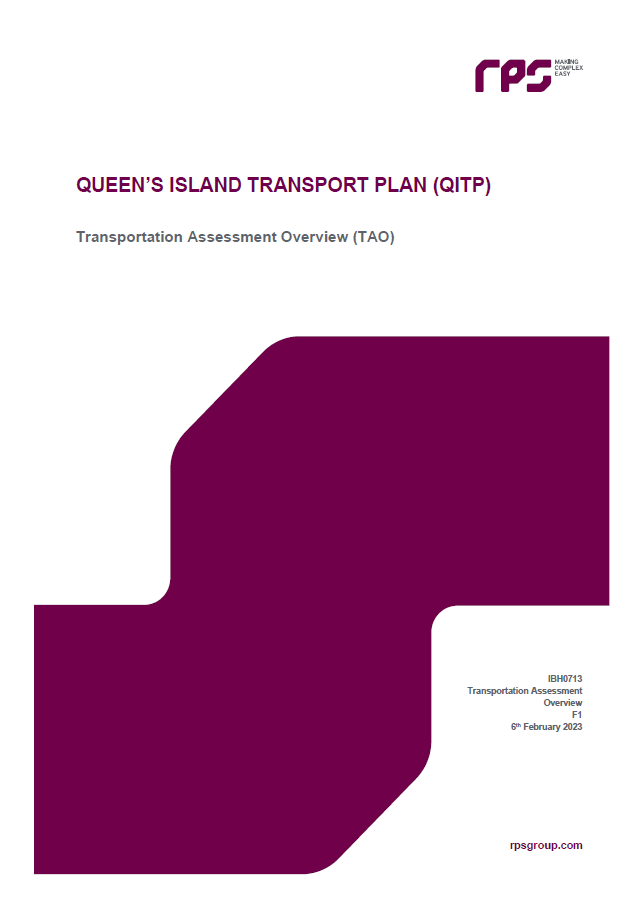
THE QUEEN'S ISLAND
TRANSPORT PLAN
The trend established in the last ten years is that private vehicle traffic generated by new development has been substantially lower than was projected – we want to accelerate this trend. By 2035, through the introduction of the QITP, with its green travel measures and transport infrastructure, we will continue to reduce reliance on cars, support public transport use and promote active travel. If successful, this will deliver sustainable development by ensuring a 30% reduction in projected new private car traffic at Queen’s Island, with a consequent reduction in carbon emissions.
Belfast Harbour and Titanic Quarter Limited have commissioned a multi-disciplinary team (RPS, Ulster University, Chapman Taylor and Turley) to develop this comprehensive sustainable transport plan, assessing our current and future economic, social value and to align investment with the principles of sustainable development and transport.
HOW YOU CAN HELP
To ensure that public and user insights informed the draft QITP, in late 2021/early 2022 we undertook early public consultation to capture feedback from people who live, work, stay and play in Queen’s Island. Participants were asked how what approaches they thought would ensure the Queen’s Island Transport Plan would benefit the people of Belfast and beyond.
The findings provided a ‘baseline’ of insights into the perceptions, travel behaviours, and preferences of those who travel to and from Queen’s Island. This baseline has informed our proposals for new green travel measures and transport infrastructure to enable future sustainable development. If you completed our previous survey, thank you.
These insights have been reported in a Statement of Community Engagement, which was used by the project team alongside our technical team’s assessments. You can find these documents, which form the Appendices to the draft QITP, here:
TRAVEL IN
QUEEN'S ISLAND
Within Queen’s Island we have already begun to implement and develop new transport infrastructure, including:
The development of the Hamilton Road (Eastern Access Road), which opened in May 2022, provided additional connectivity from Titanic Quarter Rail Halt to Queen’s Road via the wide shared cycleway / footway and Belfast Bike docking station provision.
Upgrade of existing pedestrian and cycling infrastructure from Victoria Park to Dee Street Roundabout.
Better enabling our employees, residents and visitors to plan their travel, by developing a Smart Traffic Management system, providing real time information to commuters.
These enhancements to our physical infrastructure form the foundations upon which we can build the next chapter of Queen’s Island’s socio-economic growth. Upgrades to existing infrastructure and road junctions will be supported by a suite of new and innovative active transport solutions that will enhance choice and encourage commuters to change their traditional journey habits.
OUR AMBITIONS
Our ambition for the second half of Queen’s Island’s development is to ‘double down’ on sustainability. We want to more than double our current economic and social value contribution while reducing vehicle carbon emissions to ensure that future levels do not increase.
By 2035…
A 30% reduction in traffic volume and a reduction of 98,518 tonnes CO2e.
UK Government commitments to ban new petrol and diesel car sales from 2030, will further reductions in emissions.
52% reduction in car emissions by 2050 are predicted based on current policies, and will accelerate if UK “Road to Net Zero Strategy” and Belfast’s “Net Zero Carbon Roadmap” are delivered.
Up to now…
We have pioneered sustainable development in Belfast, with 500,000 sq. ft of our developments accredited BREAAM excellent or LEED Gold.
High uptake of the ‘Belfast Bikes’ scheme, with several of Belfast’s most-used bike-share stations situated within Queen’s Island.
10% reduction in traffic has been achieved at Queen’s Island between 2016 and 2019, reducing emissions and congestion, with improved infrastructure such as the Glider Rapid Transport System being a key driver for this progress.
SOCIAL VALUE IMPACT
Our comprehensive transport plan will set how we continue to encourage modal shifts and reduce car use. By introducing more active travel alternatives for Queen’s Island employees, visitors and residents, we will support the health and well-being of all users.
Development enabled by the draft Queen’s Island Transport Plan will facilitate growth of a number of social value commitments on Queen’s Island.
By 2035…
£493.2 million total social value is expected to be generated, including an additional:
£316.1 million through work opportunities for people who were previously unemployed
£31.8 million through supporting apprenticeships
A further £2.1 million of social value generated by providing volunteering opportunities
Up to now…
£146.1 million has been generated between 2000 – 2020 through work, health and wellbeing, apprenticeships and volunteering.
Of this, over £130.7m has been generated through providing work opportunities for people who were previously unemployed
£14.6m generated through supporting apprenticeships
1,000 residents living in high quality, healthy housing at Queen’s Island
An estimated £800,000 of social value generated by providing volunteering opportunities
In addition, the QITP will support the promotion of health lifestyles through active travel and the development of healthy people focussed streets, attract visitors and supporting local employment, and create additional social value through new and existing world-class tourism and heritage assets.
ECONOMIC IMPACT
In just over a decade Queen’s Island has gone from master plan to reality. Along Belfast’s Maritime Mile we have created new public space for events, art and heritage, leisure and exercise, attracting more than 1 million visitors along the riverfront every year. It’s a thriving and bustling destination, bringing new investment and jobs to Belfast. Through the Queen’s Island Transport Plan, we want to continue this growth sustainably – in both economic and environmental terms.
By 2035…
£1.9 Billion Capital Investment
Total jobs: 27.1K (2.8% of NI)
Total GVA: £1.9BN (3.8% of NI*)
Rates Payable: £21.0M
Now in 2021…
£610M Capital Investment
Total jobs: 12K (1.4% of NI)
Total GVA: £726M (1.6% of NI)
Rates Payable: £7.3M
*This will include Gross Value Added created through construction £903M, amounting to 15,800 job years, and £423M in construction wages








